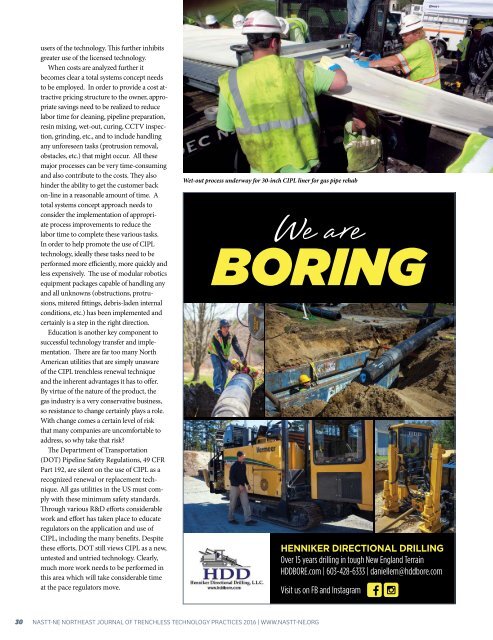PRACTICES
nastt-ne-journal-2016
nastt-ne-journal-2016
Create successful ePaper yourself
Turn your PDF publications into a flip-book with our unique Google optimized e-Paper software.
users of the technology. This further inhibits<br />
greater use of the licensed technology.<br />
When costs are analyzed further it<br />
becomes clear a total systems concept needs<br />
to be employed. In order to provide a cost attractive<br />
pricing structure to the owner, appropriate<br />
savings need to be realized to reduce<br />
labor time for cleaning, pipeline preparation,<br />
resin mixing, wet-out, curing, CCTV inspection,<br />
grinding, etc., and to include handling<br />
any unforeseen tasks (protrusion removal,<br />
obstacles, etc.) that might occur. All these<br />
major processes can be very time-consuming<br />
and also contribute to the costs. They also<br />
hinder the ability to get the customer back<br />
on-line in a reasonable amount of time. A<br />
total systems concept approach needs to<br />
consider the implementation of appropriate<br />
process improvements to reduce the<br />
labor time to complete these various tasks.<br />
In order to help promote the use of CIPL<br />
technology, ideally these tasks need to be<br />
performed more efficiently, more quickly and<br />
less expensively. The use of modular robotics<br />
equipment packages capable of handling any<br />
and all unknowns (obstructions, protrusions,<br />
mitered fittings, debris-laden internal<br />
conditions, etc.) has been implemented and<br />
certainly is a step in the right direction.<br />
Education is another key component to<br />
successful technology transfer and implementation.<br />
There are far too many North<br />
American utilities that are simply unaware<br />
of the CIPL trenchless renewal technique<br />
and the inherent advantages it has to offer.<br />
By virtue of the nature of the product, the<br />
gas industry is a very conservative business,<br />
so resistance to change certainly plays a role.<br />
With change comes a certain level of risk<br />
that many companies are uncomfortable to<br />
address, so why take that risk?<br />
The Department of Transportation<br />
(DOT) Pipeline Safety Regulations, 49 CFR<br />
Part 192, are silent on the use of CIPL as a<br />
recognized renewal or replacement technique.<br />
All gas utilities in the US must comply<br />
with these minimum safety standards.<br />
Through various R&D efforts considerable<br />
work and effort has taken place to educate<br />
regulators on the application and use of<br />
CIPL, including the many benefits. Despite<br />
these efforts, DOT still views CIPL as a new,<br />
untested and untried technology. Clearly,<br />
much more work needs to be performed in<br />
this area which will take considerable time<br />
at the pace regulators move.<br />
Wet-out process underway for 30-inch CIPL liner for gas pipe rehab<br />
We are<br />
BORING<br />
HENNIKER DIRECTIONAL DRILLING<br />
Over 15 years drilling in tough New England Terrain<br />
HDDBORE.com | 603-428-6333 | daniellem@hddbore.com<br />
Visit us on FB and Instagram<br />
30 NASTT-NE NORTHEAST JOURNAL OF TRENCHLESS TECHNOLOGY <strong>PRACTICES</strong> 2016 | WWW.NASTT-NE.ORG


